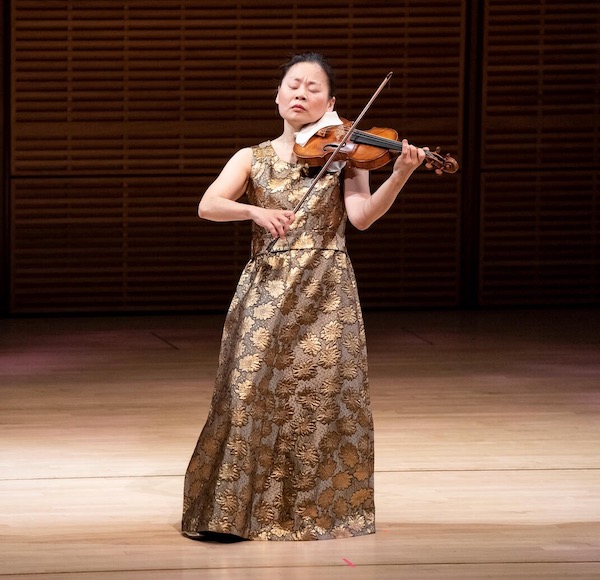Midori delivers solo Bach and the moderns at Zankel Hall

The violinist Midori stood alone onstage Thursday night at Carnegie’s Zankel Hall and gave an object lesson in realizing the intricate contrapuntal thoughts of J.S. Bach on an instrument with just four strings. The sold-out audience could read her extensive essay on the subject in the printed program, and more importantly, marvel at the depth of her performances of two sonatas and a partita by the master himself, with nary an accompanist in sight.
Two very up-to-date solo works by Thierry Escaich and John Zorn were the tangy sorbets between the substantial Baroque courses. The French composer’s four-minute solo Nun komm may have been based on a chorale tune Bach used often, “Nun komm, der Heiden Heiland,” but in no time it was spinning through a world of lightning scales, slashing chords, and impassioned cries, using novel “extended” playing techniques to put a 21st-century spin on Bach’s contrapuntal methods. Midori hurled herself into the daunting score with fire and enthusiasm.
Multiply that observation times three for Midori playing a longer piece by John Zorn, the saxophone-playing, always-surprising inhabitant of the borderlands between classical, jazz, rock and the avant-garde. His piece was titled Passagen, (Passages), as in “What’s the hardest passage in that piece?” Indeed, Zorn seemed to have created a catalogue of all the seemingly impossible things violinists have been asked to do over the centuries: blindingly fast scales and string-crossing, of course, but also left-hand pizzicato, enormous smears of glissando, stratospheric harmonics, and bow tricks galore—basically, what happens when a rock sensibility gets hold of this ancient instrument. It’s a stretch, but so it was also when Bach picked his violin up and wrote four-voice fugues on it.
Speaking of fugues, there are Bach instrumental works that wear their learning lightly, and others less so. In the solo violin world, his sonatas are derived in form and character from the old “church sonata,” which implies a certain sobriety and intellectual rigor. On the other hand, the partitas are called that because they’re party music. (Just kidding! But maybe somebody should look into that etymology.) At least, their allemandes, sarabandes, gigues, etc., evoke the dancing room, not the chapel.
So the partitas are lighter fare—until they’re not. The Partita No. 2 in D minor, with which Midori closed Thursday’s program, dances pleasantly through four standard movements, then closes with a chaconne, a slow dance in triple meter, with variations—although to describe this chaconne that way is like calling Chartres Cathedral the neighborhood church. Longer than the other four movements combined, the D minor Chaconne is one of Bach’s most awe-inspiring works, a vast journey of the emotions and the spirit.
It made a worthy ultimate destination for Thursday’s program. The road there began with the opening Grave (literally weighty, or serious) movement of the Sonata No. 2 in A minor, BWV 1003. Midori’s playing—serious but not heavy—sought expression not in vibrato but in the shape and freedom of melodies, as she illustrated the goal in her essay “to simultaneously render different lines while retaining their underlying simplicity.”
The sonata’s long fugue was the supreme test of that principle, with its high-stepping subject and running countermelodies. Thanks to the violinist’s sense of tone color and pace, this complex music flowed naturally from one arrival point to the next, and the listener’s ear never tired. The Andante, by contrast, was a study in expressive simplicity, an aria in scale phrases with a second voice lightly sketched in. The closing Allegro flew along in a single line, important notes gently emphasized, always on a curve and going someplace, and delicately embellished in the repeats—the perfect dessert.
Following Escaich’s brief, challenging piece, Bach’s Sonata No. 3 in C major, BWV 1005, stepped lightly with a dotted rhythm through a landscape of rolled chords, adagio—literally, at ease. In contrast, this sonata’s fugue—a double fugue in fact, with one smooth subject, another more angular one, and no end of running counterpoints—achieved new heights of complexity. Midori’s busy bow and flashing fingers kept all those balls in the air with aplomb. A long-lined Largo and a showy Allegro that swirled like gusts of wind closed the sonata.
In the program’s second half, the jaw-dropping virtuosity of the Zorn piece both tickled the ear and whetted the appetite for more substantial Bach. The Partita No. 2 in D minor, BWV 1004, opened with a shapely, flowing Allemande and a glittering Courante spiked with little runs. True to its traditional character, the Sarabande was introspective and ornate, the violinist making sure to keep the slow movement’s overall structure in view. The fleet Gigue was simply a gas, pure wizardry of bow and fingers.
The immensity of the Chaconne poses challenges not only of contrapuntal playing and communicating the individual character of each of the 32 variations—challenges Midori met superbly on Thursday—but of keeping the listener engaged, through pacing and suspense, over the long span of the piece. Midori’s strategy, quite effective at first, was to embark on the theme and variations modestly, in a piano-to-pianissimo dynamic, avoiding overinflection, pulling back whenever the music seemed in danger of getting too “hot.” Even a brilliant series of string-crossing variations began pianissimo before finally bursting into full sunshine.
But without some fury preceding them, the tender D major variations at mid-movement came not as balm, but as just more variations. And with the return to D minor, this listener found himself almost involuntarily counting variations (“five more to go…”), never a good sign. Closing the Chaconne with a return home to the original theme, Midori was rewarded with an ovation that justly recognized the splendor of Bach’s creation and the excellence of her playing. To be truly transported by the experience would have to wait for another night.
Carnegie Hall presents violinist Joshua Bell and pianist Daniil Trifonov performing sonatas by Beethoven, Prokofiev and Franck, 8 p.m. Feb. 28. carnegiehall.org.